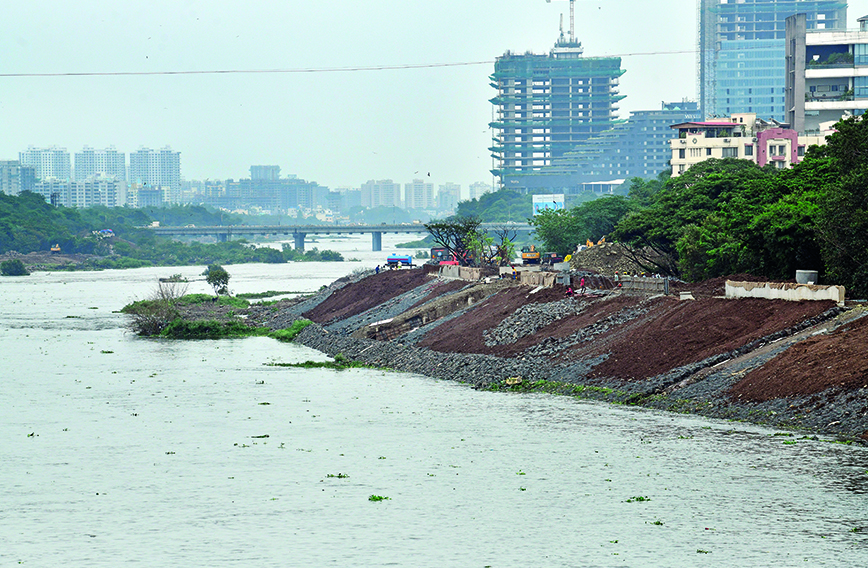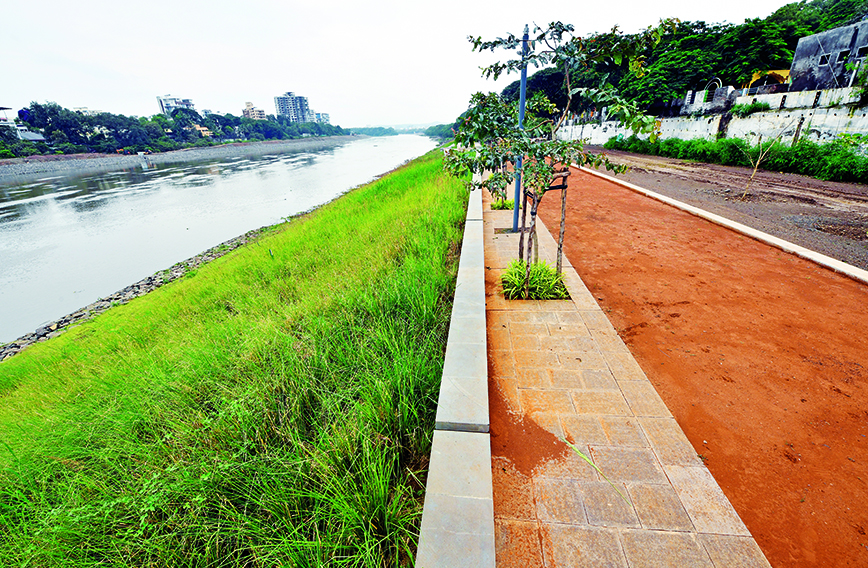
Earthmovers at work on the bank of the river
Riverfront makeover in Pune is underway with many concerns
Rina Mukherji, Pune
LIKE most Indian cities Pune has a dirty, stinky river flowing through it. So, when the Pune Municipal Corporation (PMC) unveiled an ambitious Pune Riverfront Rejuvenation Project that promised to give the city a clean river and a pretty riverside, no objections were raised.
“The public was consulted, and everyone agreed to the project. But that was because they were not presented with the true picture. People were promised a clean, free-flowing river. Who would not welcome that?” says Sarang Yadwadkar, who is an architect and urban planner.
A closer look revealed that the project was faulty on many counts. Yadwadkar points out that the project is technically flawed. It will, in fact, throttle the river, flood the city during the monsoon and actually not clean up the river.
Inspired by Ahmedabad’s Sabarmati Riverfront Project, the Pune Riverfront Rejuvenation Project will cost around Rs 5,500 crore. The PMC, however, says the project, which was conceived in 2016, will improve river flow and tackle water pollution by setting up sewage treatment plants (STPs). Drainage and sewage works will be undertaken. Embankments will be built for flood protection and encroachments removed. Access to the river will be improved. Pedestrian and cycling pathways will be built along the riverfront promenade.
It is important to understand the topography and geography of Pune to comprehend the implications of this project. Five rivers flow into Pune — the Ramnadi, Devnadi, Mula, Mutha and Pawna. These combine to form a single river system, the Mula-Mutha.
The river bifurcates the city into two. During the Peshwa regime, the population of Pune was concentrated on just one bank of the river, around the Mula-Mutha confluence. Once bridges were built and a public transport system put in place, in the early decades of the last century, settlements arose on the other bank too.
Very soon, the city expanded on both sides of the river, and spilled beyond. The city’s population increased manifold, heavily polluting the Mula-Mutha. Encroachments came up along both banks. Today, the riverbanks abound in solid waste and filth with little water in most parts of the river, except during the monsoon months. The river is filled with sewage outfalls.
 The city has steadily encroached on the river
The city has steadily encroached on the river
Upstream, there are four dams on the Mutha, namely, Khadakvasla, Temghar, Panshet and Varasgaon, and one dam, the Mulshi Dam, on the Mula river. In addition, there is the Pawna Dam on the Pawna river, and the Kasarsai Dam on the Kasarsai nullah which flows into the Mula river. Water flows in from seven different catchments with a single outlet, making Pune very flood-prone. Encroachments, dams and pollution through untreated sewage have affected the flow of the river system, which the River Rejuvenation Project is intended to handle.
Environmentalists, along with Yadwadkar and Anu Aga, a former Rajya Sabha MP and industrialist, approached the National Green Tribunal (NGT), questioning the granting of an Environmental Clearance (EC) to the project. The challenge was upheld by the NGT, which called for an amended EC. But the PMC continued construction work, defying the NGT order. Yadwadkar and his team approached the NGT once again with an Execution Application. Unfortunately, the appeal was quashed, with the NGT maintaining that work could not be stopped since it would mean a big loss to the public exchequer. However, no new work orders were to be issued for the project.
Yadwadkar points out that the project’s plans to contain floods is unsound. He says there are two aspects to be considered when looking at the flow of rivers: qualitative and quantitative. Qualitative refers to what flows in the river or how polluted the water is. Quantitative refers to the amount of water that flows in the river.
“The two are independent of each other,” he explains. “To work out the flood level, you need to look at the peak flow from the dams, as well as the flow from the Free Catchment Area (FCA), which is the area between the dams and upstream of the city. You also need to consider the confluence effect, that is, the backflow when two rivers meet at their confluence. In Pune, there are three confluences: Mula-Ramnadi, Mula-Pawna and Mula-Mutha.”
The effect of climate change has also not been factored in. Every city today witnesses heavy rain leading to waterlogging.
“In 2014, a study submitted by The Energy & Resources Institute (TERI) clearly stated that there would be a 37.5 percent increase in the annual rainfall in Pune Division, with a drop in the number of rainy days in the Sahyadris. This means there will be a much higher quantum of rain within a short span of time, resulting in reduced percolation and hence, heightened risk of flooding. All these factors affect the flood level. If you are going to disregard even one of these, your calculations will go completely wrong,” he says.
The project pays scant attention to the blue and red lines of the river, which mark the highest flood level reached in 25 years, and 100 years, respectively, says Yadwadkar. In 2019, Pune witnessed a marathon bout of rain. The Ambil Odha, a tributary of the Mutha which rises in the Katraj hills within the city, overflowed and caused 25 deaths, along with widespread damage to houses and other property.
Yadwadkar also questions the building of embankments. Such construction will constrict the river and further impede its flow. “As per their own data, there will be a 1.53-metre rise in water level after completion of the project. A rise of 1.53 m amounts to five feet; this translates into submergence of several km of land. How is this going to check flooding?” he asks.
The Environmental Clearance, Yadwadkar points out, was given on the premise that no construction work was to be undertaken on the floodplains of the river. Instead, there is a lot of construction going on with the intention of putting up promenades, food plazas, cycling paths and flea markets. The embankments, too, will be on the floodplains of the river.
“The floodplains of the river are important. You cannot build there. A variety of plants and grasses grow there. The floodplains are a world of their own. Birds come for food. Dumping soil for artificial beautification will result in the irreversible loss of this biodiversity. The river will end up being a concrete coffin,” he says.
Shiv Sena leader and former minister Aditya Thackeray, who is also a keen environmentalist, had criticized the riverfront project, warning of dire consequences. “Do we want to turn Pune into another Joshimath?” he had quipped on a recent visit to the site.
 A 300-m model stretch of the riverfront
A 300-m model stretch of the riverfront
However, neither Yadwadkar nor the environmentalists are against the removal of encroachments or cleaning of the river. “We have been demanding the removal of encroachments for the past 10 years,” he said. They have also welcomed the building of sewage treatment plants (STPs) under the aegis of the Japan International Cooperation Agency (JICA), as part of river rejuvenation, despite their reservations on the quantum of clean-up that would be achieved.
Yadwadkar explains the maths. The total daily amount of water consumed by the city is 1,732 MLD which is supplied by the Water Resources Department. In addition, 310 MLD of groundwater is supplied through tankers. Out of this total amount of 2,042 MLD, 80 percent or 1,634 MLD is generated as sewage. At the moment, the existing STPs are capable of handling a mere 477 MLD at full capacity. The 11 new STPs to be set up under the JICA project are going to treat 396 MLD. Besides, two private STPs will treat another 132 MLD.
“But even if we assume that the sewage generated will remain at the present level, it leaves an untreated deficit of 629 MLD. Hence, the river will continue to be polluted by untreated raw sewage,” he says.
What has especially irked environmentalists and Yadwadkar is the felling of trees for the project. “When they were getting their EC, they had declared that they would not remove a single tree. Now suddenly, they are going to remove thousands of trees, and transplant others. They talk of transplantation. What is their record of transplantation? How many transplanted trees have survived, to this day?”
The PMC has been talking of only removing “exotic species”, a claim Yadwadkar dismisses. “And who are they to decide what are native, and what are exotic species?” he asks.
Yadwadkar, along with activist Pushkar Nadkarni, had approached the NGT on the issue, since the original Detailed Project Report (DPR) had stated that existing trees would be retained, with additional green areas being added to the riverfront under the project. As matters stand, according to an order passed in July 2023, the NGT has directed the PMC not to cut down any trees unless it has approval and environmental clearance from the Tree Authority of the Maharashtra government.
Every city wants a riverside free of encroachments, garbage, and pollution. But a river is a river. It must flow freely, with its floodplains and biodiversity intact. The PMC needs to involve environmentalists and urban planners and come up with a smart green plan which will make other cities sit up and take note.
Comments
Currently there are no Comments. Be first to write a comment!




